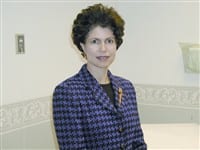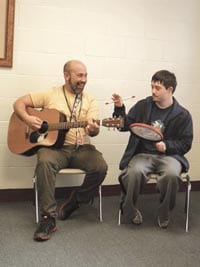Put To The Test Women Continue To Receive Mixed Messages About Breast Self-exams
What’s a woman to do?
In an age of mixed messages in health care, the topic of breast cancer — and what should be done to prevent and check for it — has become one of the more cloudy areas for doctors and anxious patients alike.
Now, a new report seeks to downplay something many doctors stress: the importance of breast self-exams.
The study of more than 266,000 women in China that was published last month in no less prestigious a publication than the Journal of the National Cancer Institute suggests that self-exams are essentially a waste of time for doctors and patients.
“The women were not able to detect lumps early enough to make a difference,” said Dr. David Thomas, a researcher at the Fred Hutchinson Cancer Research Center in Seattle and the lead author of the published study.
However, because the subjects of the China study were women with no access to mammography or other clinical exams, the report doesn’t tell the whole story, said Dr. Grace Makari-Judson, medical director of Baystate Medical Center’s Comprehensive Breast Center.
“They did not find a difference in the risk of dying from breast cancer when the breast-self exam was used by itself,” she said.
Meanwhile, she noted, decades of studies and statistics in the United States, where women have access to a wide variety of options, show that self-exams used in conjunction with mammograms and clinical examinations do make a difference in catching instances of cancer before it becomes deadly.
Shanghai Surprise
In the China study, researchers taught half of the test group, all of them factory workers in Shanghai who had no access to professional cancer screenings, how to conduct breast self-exams, but they did not instruct the other half about the technique.
After more than a decade, 135 women in the instruction group died of breast cancer, while 131 died of breast cancer in the control group. Researchers wrote that the differences “are not statistically significant” and determined that, more than anything, the study shows that self-exams alone aren’t an effective cancer deterrent.
Thomas conceded as much in his report, saying that the study suggests that, in poorer countries where mammography is not widely available, public health officials should not spend limited health funds on teaching breast self-exams, but should instead direct that money to more effective health programs, such as immunizations.
“If a woman chooses to do BSE, then she’s got to do a very good job, and she’s got to realize it is unproven,” Thomas said, adding that it’s important not to rely on self-exams as a substitute for mammography.
Taken in proper context, Makari-Judson said, the study tells more about a specific population and its public health policy than it does about the effectiveness of breast self-exams.
“Strictly speaking, the message of that study is not to spend health care dollars on a large campaign to teach women about breast self-exams,” she said. “I think it’s still important, and we still promote it at the Breast Center as part of the triple approach to screening.”
Those three steps include monthly breast self-exams starting at age 20, yearly clinical breast examinations starting at age 30, and yearly mammograms at age 40.
“Not all women are comfortable doing breast self-exams, and that’s all right,” Makari-Judson said. “It’s still important for them to have an awareness and to know about possible signs of cancer.”
Strategy Shift?
Despite the insistence of many doctors that any multi-strategy approach should include breast self-exams, the NCI is taking the Shanghai study seriously. Not only did it publish the report in its journal, it also ran an editorial by Dr. Russell Harris and Dr. Linda Kinsinger of the University of North Carolina Department of Medicine, who claim the study “should lead us to change our clinical practice.” Doctors in the United States, they wrote, should stop spending time teaching women how to perform self-exams and concentrate more on clinical exams.
Doctors also note that, whether or not a woman performs self-exams, simple awareness of her body can go a long way toward finding problems. For its part, even though it downplays the importance of routine self-checking, the NCI does offer advice for women who find a lump.
If both breasts feel the same, the organization notes, lumpiness is probably normal but should be mentioned to a doctor. But a doctor should be consulted immediately if the lump is new or unusual, particularly if it doesn’t go away after the next menstrual period, or if the woman finds a nipple discharge or dimpled or puckering breast skin, even without feeling a lump.
In addition, the NCI explains, an irregular, hard lump is more likely cancerous than a soft, round one, but only a biopsy can definitively rule out cancer. The organization advises women not to hesitate to get a second opinion if they are worried that a doctor wants to monitor the lump instead of performing immediate biopsies.
Even if a woman doesn’t do the regimented monthly breast self-exam, it’s still important for her to have an awareness and, obviously, bring any concerns to her health care provider,” Makari-Judson said.
Clearly, however, the China study has given some support to doctors who want to de-emphasize the importance of self-exams.
“Women should not feel guilty about not doing breast self-exams,” said Dr. Robert Smith, an American Cancer Society epidemiologist, who noted that women are at least as likely to discover breast lumps while dressing, showering, or having sex as they are to find one during a set-aside time for checking.
Positive Numbers
However, doctors who want women to continue self-checking point to statistics to back up their contention.
“The average size of tumors today has gone down dramatically,” Makari-Judson said. “In 1970, 30{06cf2b9696b159f874511d23dbc893eb1ac83014175ed30550cfff22781411e5} of cancers were 2 centimeters or less in size. Today, it’s 70{06cf2b9696b159f874511d23dbc893eb1ac83014175ed30550cfff22781411e5}. We know women are coming in with lumps that are smaller than they were before. That may just be awareness; it may not be because of monthly breast self-exams. But, clearly, this is a very important change because smaller tumors are less likely to have associated lymph node involvement and are less likely to cause death.”
Even mammograms have critics. Two Danish statisticians recently re-examined the trials from the 1970s and 1980s which seemed to determine that mammograms reduce the risk of death from breast cancer by 30{06cf2b9696b159f874511d23dbc893eb1ac83014175ed30550cfff22781411e5}. The pair suggested that the trials were flawed and the risk-reduction rate possibly overblown. And a recent Canadian study suggested that the main effect mammograms have is to make women anxious and lead to unnecessary surgery.
But Makari-Judson notes that in the late 1980s and early 1990s, the death rates from breast cancer started going down and have continued to fall by about 2{06cf2b9696b159f874511d23dbc893eb1ac83014175ed30550cfff22781411e5} each year — this after 50 years of no change.
The positive change may, in fact, be a result not of one technique but a combination of several, she said — hence the three-pronged approach.
“Mammograms pick up 90{06cf2b9696b159f874511d23dbc893eb1ac83014175ed30550cfff22781411e5} of cancers, but 10{06cf2b9696b159f874511d23dbc893eb1ac83014175ed30550cfff22781411e5} cannot be seen on a mammogram but may be detected because of clinical breast exams. Women will do best with a combination of techniques.”
As supporters of regular self-exams point out, when a disease kills more than 40,000 Americans each year, as breast cancer does, it doesn’t hurt for women to check — and check again.


